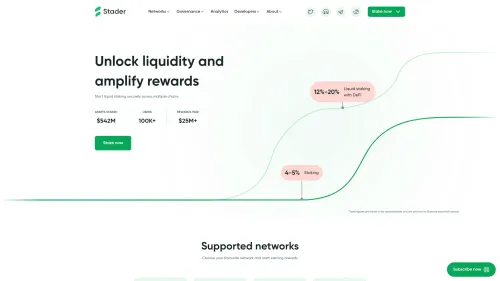Stader (SD)
Stader is a non-custodial, multi-chain liquid staking platform designed to simplify and enhance staking experiences across various Proof-of-Stake (PoS) networks. By enabling users to seamlessly access top staking opportunities and the most rewarding decentralized finance (DeFi) options, Stader is carving out a niche in the evolving blockchain ecosystem. It operates on networks such as Ethereum, Polygon, BNB, and Hedera, catering to a diverse clientele that includes retail users, exchanges, custodians, and institutions. The platform is trusted by over 85,000 stakers, offering them efficient ways to earn rewards through staking their crypto assets.
Features of Stader
Multi-chain support

| Ticker | SD |
| Category | BNB Chain Ecosystem |
| Website | https://staderlabs.com/ |
| Contract Addresses | |
|---|---|
| ethereum | 0x30...0f Copied! Copied! |
| fantom | 0x41...c6 Copied! Copied! |
| binance-smart-chain | 0x3b...e8 Copied! Copied! |
| polygon-pos | 0x1d...94 Copied! Copied! |
Stader stands out for its multi-chain capabilities, allowing users to engage with multiple PoS networks from a single platform. This integration facilitates broader participation in the staking ecosystem, giving users the flexibility to choose among various networks according to their preferences and strategic goals. The networks currently supported include Ethereum, Polygon, BNB, and Hedera, each offering unique advantages and opportunities for staking.
Non-custodial platform
One of the core features of Stader is its non-custodial nature. This means that users have complete control over their private keys and assets, ensuring enhanced security and reducing the risk associated with centralized control. By maintaining full custody of their crypto assets, users can engage with the staking process confidently, knowing that their investments are secure.
Liquid staking
Stader provides a liquid staking mechanism, which allows users to unlock the liquidity of their staked assets. This feature ensures that while participating in staking, users can still utilize their assets in other DeFi activities. Liquid staking bridges the gap between staking and other DeFi opportunities, enhancing the overall utility and efficiency of users' crypto holdings.
The SD token
Overview of SD
The SD token is the governance token of the Stader platform. It is an ERC-20 token with a maximum supply of 120 million tokens, distributed among over 23,000 holders. The token is integral to the Stader ecosystem, offering various utilities that enhance both its value and functionality within the platform.
Utilities of SD
SD utility pool
The SD token is pivotal in promoting ETH decentralization through the SD Utility Pool. This unique feature rewards SD holders who contribute to the decentralization efforts by delegating to the pool. Such initiatives not only incentivize participation but also strengthen the network's overall security and resilience.
Liquidity mining
SD holders can engage in liquidity mining by providing SD liquidity across decentralized exchanges (DEXs). This allows them to earn incentives, subject to governance approval. Liquidity mining is an essential mechanism for enhancing the token's liquidity and availability, facilitating smoother transactions and exchanges.
Node operator bond
For permissionless node operators working with ETHx, bonding SD tokens is a requirement. Specifically, each validator must bond a minimum of 0.4 ETH worth of SD. This requirement ensures that node operators have a vested interest in the network's success and stability, aligning their goals with those of the broader community.
Governance and voting
The SD token plays a critical role in the governance of the Stader protocol. Token holders can participate in voting on various aspects of the platform, including protocol upgrades, reward policies, validator selection criteria, and protocol expansion. This democratic approach empowers the community to influence the platform's future direction and development.
